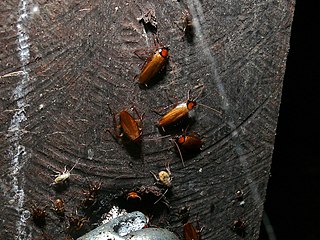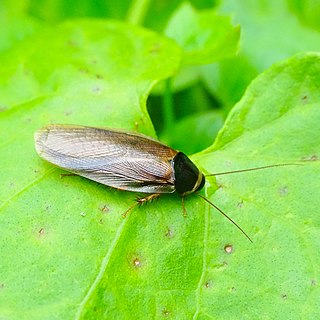| Pseudophoraspis | |
|---|---|
 | |
| Pseudophoraspis sp. | |
| Scientific classification | |
| Kingdom: | Animalia |
| Phylum: | Arthropoda |
| Class: | Insecta |
| Order: | Blattodea |
| Family: | Blaberidae |
| Genus: | Pseudophoraspis Kirby, 1903 |
Pseudophoraspis is a genus of cockroaches.
| Pseudophoraspis | |
|---|---|
 | |
| Pseudophoraspis sp. | |
| Scientific classification | |
| Kingdom: | Animalia |
| Phylum: | Arthropoda |
| Class: | Insecta |
| Order: | Blattodea |
| Family: | Blaberidae |
| Genus: | Pseudophoraspis Kirby, 1903 |
Pseudophoraspis is a genus of cockroaches.

Asymblepharus is a genus of skinks. The genus has been confused with and is very similar to Scincella.

Salamandridae is a family of salamanders consisting of true salamanders and newts. Salamandrids are distinguished from other salamanders by the lack of rib or costal grooves along the sides of their bodies and by their rough skin. Their skin is very granular because of the number of poison glands. They also lack nasolabial grooves. Most species of Salamandridae have moveable eyelids but lack lacrimal glands.

Giant cockroaches, or blaberids are the second-largest cockroach family by number of species.

Blattidae is a cockroach family in the order Blattodea containing several of the most common household cockroaches. Some notable species include:

Ectobiidae is a family of the order Blattodea (cockroaches). This family contains many of the smaller common household pest cockroaches, among others. They are sometimes called wood cockroaches. A few notable species include:

Megophrys is a genus of frogs in the family Megophryidae. They occur in the mainland Southeastern Asia, the islands of the Sunda Shelf, and the Philippines. They commonly have elongated upper "eyebrows" and are thus known as Asian horned frogs.

Paramesotriton, also known as warty newts or Asian warty newts, is a genus of salamanders in the family Salamandridae. The genus is found in southwestern and southern China and in northern Vietnam. Most of the species are endemic to China, and the majority of them have been described recently, since 2008. The genus includes both pond and stream dwellers.

Triplophysa is a genus of fish in the family Nemacheilidae found mainly in and around the Qinghai-Tibet Plateau in China. Currently, the genus is a mixed assemblage of species. Some lineages have been identified and treated as subgenera, but as Wikipedia follows Fishbase for fish species these have been treated as subgenera in Wikipedia, although Kottelat and the Catalog of Fishes treat them as genera. FishBase, however, includes these in Triplophysa without specifying subgenera and treats the names given by Kottelat as synonyms.

Pachytriton, also known as the paddle-tail newts or Chinese newts, is a genus of salamanders in the family Salamandridae. They are found in southeastern China.

Diploptera, also known as the beetle cockroach, is a genus of blaberid cockroaches. Cockroaches of this genus resemble beetles, with hardened tegmina and cross-folded hindwings. They live in tropical forests in South China and Southeast Asia, and Pacific islands including Hawaii. They are viviparous cockroaches and are therefore used for insect endocrinological studies. There are eight known species and two subspecies.

Lecithocera is a genus of moths in the lecithocerid subfamily Lecithocerinae. The genus was erected by Gottlieb August Wilhelm Herrich-Schäffer in 1853.
Torodora is a genus of moths in the family Lecithoceridae. The genus was erected by Edward Meyrick in 1894.
Huwentoxins (HWTX) are a group of neurotoxic peptides found in the venom of the Chinese bird spider Haplopelma schmidti. The species was formerly known as Haplopelma huwenum, Ornithoctonus huwena and Selenocosmia huwena. While structural similarity can be found among several of these toxins, HWTX as a group possess high functional diversity.

Gergithus is a genus of planthoppers in the family Issidae. Like all planthoppers, adults feed on plant sap and are capable of escaping by leaping. The genus like other members in the tribe appears somewhat rounded and beetle-like, in some cases, with a mimetic resemblance to ladybird beetles. About 60 species are known in the genus and they are distributed in the Indomalayan and Palearctic Realms.

Neostylopyga is a genus of cockroaches described by Robert Walter Campbell Shelford in 1911. Some of the species are strikingly coloured and patterned and are popular in cultures under the common name harlequin roaches or harlequin cockroaches.
Zhao Ermi was a Chinese herpetologist, born in Chengdu. His ancestors were Manchu Bannerman of Irgen Gioro clan who were stationed in Chengdu during Qing Dynasty. He was elected a member of the Chinese Academy of Sciences in 2001. He died at West China Medical Center of Sichuan University on 24 December 2016.

Symploce is a genus of cockroach in the family Ectobiidae.

Diploderma is a genus of lizards in the family Agamidae. Species of Diploderma are native to Myanmar, China, Vietnam, Taiwan, and Japan. Most of the species are found in China, including many endemics.

Pycnoscelus is a genus of cockroaches in the family Blaberidae. There are about 15 described species in the genus Pycnoscelus.

Opisthoplatia is a genus of cockroaches in the family Blaberidae. There are at least two described species in Opisthoplatia, found in south and east Asia, and Indomalaya.